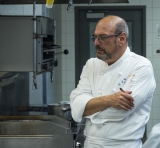
Tracing Honey to Its True Source
A new initiative aims to keep honey sourcing pure and secure.

A new initiative aims to keep honey sourcing pure and secure.

This food waste saying – Start Small and Finish It All - was taught to my daughter when she was an outdoor education instructor between 2013 and 2014 in Occidental, Calif.

Dr. Fred Mayo reviews important details every syllabus should include.

Chef Jackson Lamb earns prestigious award for curriculum development and student study abroad trip.
Students will cook and learn within the historical and cultural contexts of southern Italy interacting with chefs, growers, and food producers in a truly immersive study abroad program.

The following videos feature presentations from the 2016 Leadership Conference:

Ten award winners were revealed at CAFÉ’s annual conference in June. Additionally, attendees were treated to informative sessions designed specifically with chef educators in mind.

Here is a complete list of award recipients and brief description of their accomplishments.

Chef educators are tasked with demands to stay relevant while teaching soon-to-be graduates “kitchen-ready” skills all the while meeting institutional standards. A difficult task that can be accomplished with assistance. Educators, you are not alone!

Want to brand your program or product with unique techniques? Come to CAFÉ’s fall workshop and learn how to manage (or create) your culinary image using both traditional and social media.